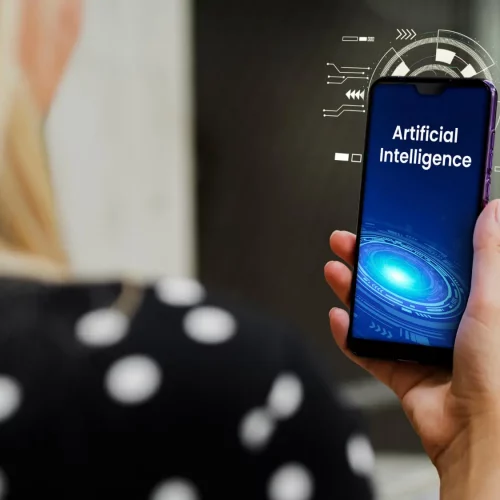
Introduction
Humans have an attention span that’s less than that of a goldfish, so you must be available around the clock to answer any query from your customers to avoid losing them to competitors.
Imagine this: you are an American brand catering to clients in Europe now when a prospective customer messages you about certain specifications related to your product. Meanwhile, your team cannot revert because it might be beyond their duty hours.
If the customer’s query is not answered, they might just look for an alternative option, and let’s be honest, they are spoilt for choice. But by implementing a conversation AI technology, you can answer the most commonly asked questions related to your brand.
This is an ideal example of conversational AI use cases.
Conversational AI-powered solutions are great for helping your company’s customer care department.
A conversational AI-bot first appears to solve your client’s query. However, the call can be diverted to human executives for complex questions. This advanced technology can seamlessly have conversations with humans, help to free up call wait times and reduce the workload of the client representatives.
From today’s guide, let us learn in depth what these tools are and some of the popular conversational AI use cases in different industries.
What is Conversational AI?
Firstly, you must understand conversational AI is not a chatbot. Why? Chatbots automate your conversation to respond quickly to users. These, most of the time, look robotic and lack personalization.
On the other hand, conversational AI uses natural language processing (NLP) to provide natural and adaptable responses to users. These tools combine advanced automation, NLP, and artificial intelligence to respond like humans. Real-life examples of conversational AI use cases include Siri and Alexa.
This application was first developed for entertainment purposes but is now a vital part of the digital ecosystem. Research says that by 2030, the world market for conversational AI is expected to reach $32.62 billion.
Conversational AI use cases benefit almost every industry by addressing their needs and offering tailored solutions.
The main types of conversational AI include
- Advanced Chatbots
- Voice bots/assistants
- IVA (Interactive voice assistants)
While chatbots are text-based AI tools, voice assistants ensure interaction through voice commands. IVAs is an automated phone system technology that helps incoming callers interact with a computer-operated telephonic system.
How Does Conversational AI Work?
Conversational AI working can be broken down into multiple steps that begin with data collection and end with producing human-like responses. These systems use NLP and other advanced algorithms to create content-rich dialogues. The broader range of user inputs to the system improves their pattern recognition and predictive analysis.
Let’s break the working of Conversational AI into four steps.
Input Collection
It is the first step where a user inputs their query to the system through text or voice.
Input Processing
Once the system receives the query in text form, its NLU (Natural Language Understanding) starts processing the data and extracting meaning from the words.
For voice inputs, they use ASR (Automatic Speech Recognition) to convert audio into small language tokens to analyze them and extract the meanings.
Response Generation
At this step, the system uses natural language generation techniques to respond appropriately to the user’s query.
Continuous Improvement
The system works with bulk data, allowing them to improve their responses’ accuracy and relevance continuously.
What are the Benefits of Conversational AI?
Conversational AI has quickly gained popularity in businesses of all sizes because of its benefits. They streamline your administrative tasks, improve customer experience, and give you a competitive advantage.
Cost Efficiency
Staffing your customer service department can be costly as you must pay them market-appropriate salaries and benefits. However, implementing a conversational AI system can deal with initial customer queries while your in-office representatives solve complex cases.
Additionally, you can automate bulk tasks with these systems, thereby reducing operational costs for errors associated with manual data entry.
Timely Response
Businesses may often skip replying to prospects unintentionally, negatively impacting sales. But these systems can understand your client queries and respond to them naturally 24/7. This way, you can convert prospects into customers and retain existing clients.
Resolve Low-Value Calls
Conversational AI and virtual assistants help you resolve low-value calls and release your customer service teams during increased call spikes. You can also categorize calls based on consumer needs, past interactions, and intent. While AI solves repetitive questions, your team can focus on high-value conversations.
Automate Mundane Tasks
Not all activities in your business require human effort. Tasks like scheduling appointments, gathering client data, handling specific human resource tasks, etc, can be handled by conversational AI. This can free up your time for core business activities and tasks that require human judgment and attention.
Conversational AI Use Cases in Top Industries
Are you wondering what the use cases for conversational AI are? We have shared some of the top industries that use conversational AI today.
Healthcare
Conversational AI use cases in healthcare are used for diagnosing patients’ health conditions online, scheduling appointments, sending reminders, post-recruitment care, etc.
For example, you previously had to share all your health concerns with an assistant, who then would take you to the doctor. But now, doctors don’t need that medical assistant in the middle to learn your concerns.
Financial Services
As more and more customers rely on digital financial services, companies are suffering in handling bulk clients. With conversational AI, they can communicate clearly and instantly deliver information to users without compromising security.
E-Commerce
Conversational AI use cases in e-commerce include gathering client information and providing relevant product details and recommendations. They also help answer FAQs (frequently asked questions), help clients place orders and returns, and initialize cross-sells and upsells. Thus, such systems have the potential to improve customer satisfaction.
Insurance
Like other industries, conversational AI is also used in the insurance industry. It helps companies to resolve conflicts and claims in a faster and more reliable way. You can also eliminate waiting times, provide policy recommendations, gather feedback and reviews, and create customer awareness about policies.
Safety and Security
Conversational AI uses voice recognition features to identify speakers before functioning. They are mainly used in security applications where the devices first recognize your voice before giving you access to its functionalities. Additionally, voice biometrics prevents theft, document duplications, and data breaches.
Also Read :
Conclusion
Most organizations now accept conversational AI use cases to improve customer support and automate mundane tasks. They ensure your clients don’t wait longer for a response, and you lose your prospects in the process.





